20 February, 2002
GIANT PETRELS AND FEW OTHER SEABIRDS
The Antarctic Peninsula is home to many seabirds. Penguins
may be the seabirds people first think about, but here at Palmer we see
petrels, skuas, cormorants (Blue-eyed Shags), sheathbills, kelp gulls, and
terns. When people travel across the Drake Passage on the LM Gould, they
also see albatrosses, fulmars, and prions.
These seabirds are part of the Antarctic marine food web. They are
predators. Many of the birds eat krill, squid, and small fish. Others
primarily are scavengers, eating carrion (dead animals of any size, even
seal or whale carcasses). They also eat the eggs and chicks of other birds.
By studying the seabirds, scientists learn more about the ecosystem of the
Antarctic Peninsula.
Donna Patterson and Bill Fraser coordinate a team of scientists collecting
data on the population and breeding biology of the seabirds found in this
area. Donna specializes in studies of the giant petrels. These scavengers
grow to be 85-99 cm long, with a wingspan from 185-205 cm across. The
petrel lays an egg in November. Both parents take turns incubating the egg
(sitting on the nest) for about sixty days. Once the egg hatches, the
parents continue to share the brooding, guarding, and feeding of the chick.
One parent remains on the nest while the other goes out to forage for food.
After about eighteen days, the chick can be left alone by both parents. The
parents still return to feed the chick. The petrel chick will fledge and
leave the nest in the last week of April.
The petrel parents make flying trips out to forage (search) for food. A
short local trip may last less than a day. Longer foraging trips may be as
long as six days. Donna has learned a lot about giant petrels through close
observation over many years. She also has received information about petrel
behavior from the transmitters attached to a few of them.
It is important to know about the feeding behavior of petrel breeding pairs.
This gives the scientists information about other parts of the food web
here. Petrels are "serious predators" on Adelie penguin chicks, according
to Bill Fraser. So by studying petrels, scientists learn about potential
impacts on Adelie penguin populations.
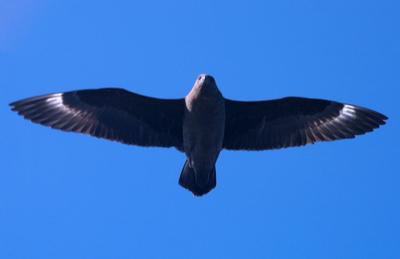
This skua flew over a Zodiac when Cara Sucher was there with her camera! Thanks, Cara, for sharing this unusual photo. The skua is a scavenger, but it also is a "surface feeder". It will swim and grab krill or fish. It also may plunge dive beneath the surface of the ocean.
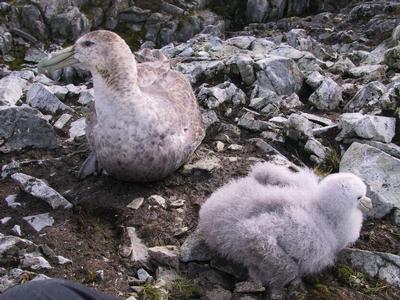
Compare the size of this chick in this photo taken today, with the photo taken on January 22, 2002.
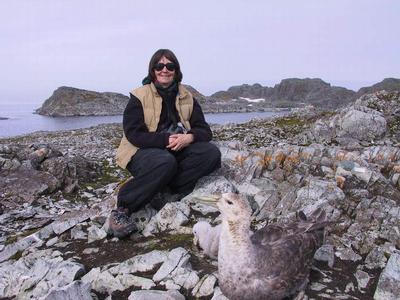
This photo was taken this morning on Humble Island. Donna Patterson had just finished inspecting the chick. The parent and chick are not concerned that I have been watching the process.

Donna Patterson is borrowing this petrel chick from its parent for a few moments, so that she can weigh the chick. This photo was taken on Humble Island on January 22, 2002. Compare the size of the chick with the photo taken February 20, 2002.
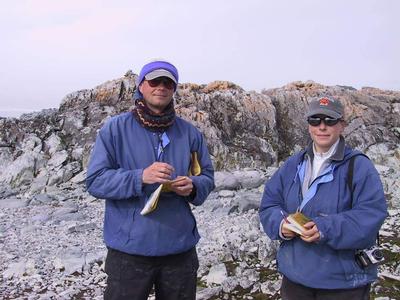
Bill Fraser and Donna Patterson head the team of scientists studying seabird ecology. Here they have been comparing notes about their field observations.
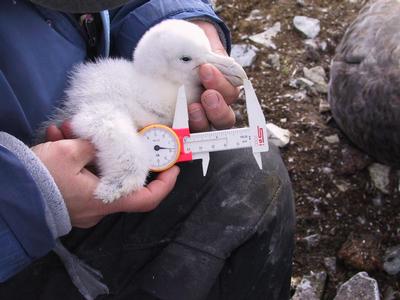
In late January, Donna Patterson measures a chick. She will check this specific chick again many times (along with several other chicks) as the growing season continues. You can see the side of the parent petrel on the far right of the photo.
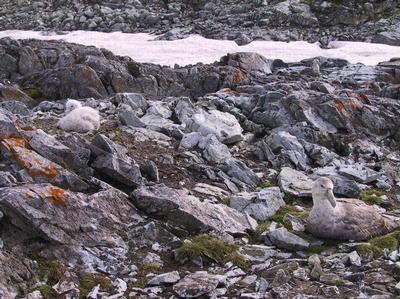
Can you find the petrels--parent and chick--in this photo? They are well-concealed on their rocky nest.
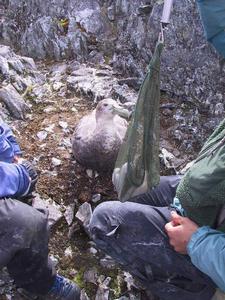
The petrel chick is being weighed while the parent looks on. Donna Patterson will slowly reach under the parent on the nest and bring out the chick to be weighed.

A giant petrel parent and chick on Humble Island. This photo was taken January 22, 2002. The chicks are quite large now. They do not need to have their parents lying on top of them. It might be uncomfortable for both parent and chick!
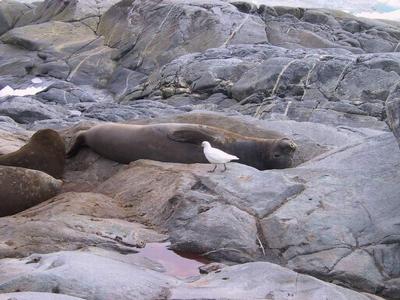
A pair of sheathbills has been living around the station. These birds seem to prefer to run than to fly, though they certainly can fly. Sheathbills eat a lot of different things. They are scavengers and food thieves. Sometimes they wait for food dropped by other birds. Other times they will eat the seal and bird feces (droppings). This pair of sheathbills likes to walk around "the lounge" outside BioLab. This is the rocky place where the elephant seals lie about sleeping.
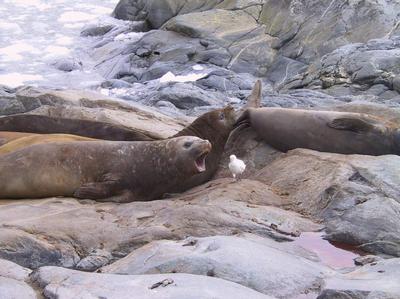
Sometimes the seals do not appreciate having the sheathbill around them.

The sheathbill ignores the seal's comment and just keeps walking around and around the pile of elephant seals.

The Blue-eyed shag, or cormorant, nests on the islands around Palmer Station. These birds feed on fish, squid, and small crustaceans and other animals living on the ocean bottom. The bird makes a quick dive down under the water, just like cormorants in other parts of the world. On the outer ring of the Palmer 2-mile limit there is a place called Cormorant Island. Guess why? This pair of shags was sitting right across Hero Inlet from Palmer Station. The bright orange is a lichen. Photo courtesy of Laura Hamilton.
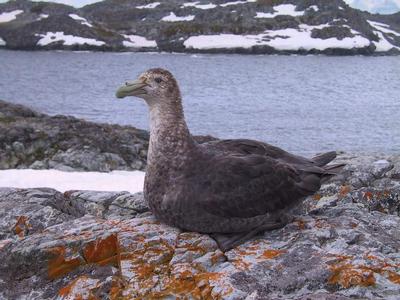
This photo of a giant petrel was taken at Humble Island on January 22, 2002. You can clearly see the petrel's hooked bill. The petrel uses it to tear its food apart--carrion (dead animals).
Contact the TEA in the field at
.
If you cannot connect through your browser, copy the
TEA's e-mail address in the "To:" line of
your favorite e-mail package.
|
